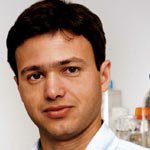Biotechnology & medicine
Yaakov Benenson
He wants to replace physicians with molecular machines that diagnose and treat diseases with phenomenal precision.
Global
Monisha Scott
Determined how small, natural proteins boost the immune response.
Global
Lei Wang
Expanded the genetic code in order to allow living cells to incorporate new, unnatural building blocks into the proteins that they make.
Global
Vasilis Ntziachristos
Facilitated noninvasive optical imaging of proteins and other molecules in the body, which could lead to ultraprecise diagnosis of cancer and other diseases.
Global
Shayn Peirce
Models how individual cells in tissues migrate, multiply, and develop during processes such as blood vessel growth. The models should aid tissue engineering and drug development.
